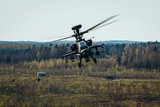DARPA completes phase one of FLA programme
The Defense Advanced Research Projects Agency (DARPA) has completed phase one of its Fast Lightweight Autonomy (FLA) programme following a series of obstacle-course flight tests in central Florida, the agency announced on 28 June.
DARPA’s FLA programme aims to enable small unmanned quadcopters to fly autonomously through cluttered buildings and obstacle-strewn environments at fast speeds of up to 20m per second using onboard cameras, sensors and smart algorithms for self-navigation.
The technology can be used for applications such as safely and quickly scanning for threats inside a building before military teams enter, or searching for a downed pilot in a heavily forested area or jungle in hostile territory where overhead imagery cannot see through the tree canopy. The quadcopter can also be used to locate survivors following earthquakes or other disasters.
The FLA programme enables UAS to operate in GPS-denied environments, such as indoors, underground, or intentionally jammed, without a human tele-operator. The only human input required is the target or objective for the UAS to search for (via pre-loaded map, satellite imagery or digital photo), as well as the direction and distance to the target. Once the launch command is given, the vehicle navigates its way to the target with no other knowledge of the terrain or environment, autonomously manoeuvring around uncharted obstacles in its way.
The four days of testing combined elements from three previous flight experiments that together tested the teams’ algorithms' abilities and robustness to real-world conditions. The test involved quickly adjusting from bright sunshine to dark interiors, sensing and avoiding trees with dangling masses of Spanish moss, navigating a simple maze, and traversing long distances over feature-deprived areas.
On the final day, the aircraft had to fly through a thickly wooded area and across a bright aircraft parking apron, find the open door to a dark hangar, manoeuver around walls and obstacles inside the hangar, locate a red chemical barrel as the target, and fly back to its starting point, completely on its own.
JC Ledé, the DARPA FLA program manager, said that success was largely a matter of superior programming.
'FLA is not aimed at developing new sensor technology or to solve the autonomous navigation and obstacle avoidance challenges by adding more and more computing power,' he said. 'The key elements in this effort, which make it challenging, are the requirements to use inexpensive inertial measurement units and off-the-shelf quadcopters with limited weight capacity. This puts the program emphasis on creating novel algorithms that work at high speed in real time with relatively low-power, small single board computers similar to a smart phone.'
Phase two will see lessons learned applied under this phase.
More from Uncrewed Vehicles
-
![What's next for the Pentagon after the Replicator programme?]()
What's next for the Pentagon after the Replicator programme?
Although the Replicator initiative has made several accomplishments, there are still multiple gaps to plug across the US Department of Defense (DoD) and its services.
-
![Cummings Aerospace showcases Hellhound loitering munition designed for US Army’s LASSO programme (video)]()
Cummings Aerospace showcases Hellhound loitering munition designed for US Army’s LASSO programme (video)
Cummings Aerospace presented its turbojet-powered Hellhound loitering munition at SOF Week 2025, offering a man-portable solution aligned with the US Army’s LASSO requirements.
-
![SOF Week 2025: PDW unveils attritable FPV drone for SOF operations at scale]()
SOF Week 2025: PDW unveils attritable FPV drone for SOF operations at scale
PDW has revealed its Attritable Multirotor First Person View drone at SOF Week 2025, offering special operations forces a low-cost, rapidly deployable platform for strike and ISR missions, inspired by battlefield lessons from Ukraine.
-
![SOF Week 2025: Teledyne FLIR white paper provides guidance on reusable loitering munitions]()
SOF Week 2025: Teledyne FLIR white paper provides guidance on reusable loitering munitions
Teledyne FLIR is highlighting the emerging requirements for 'recoverable and re-usable' loitering munitions across the contemporary operating environment during this week’s SOF Week conference in Tampa, Florida.
-
![SOF Week 2025: Kraken Technology group debuts K3 Scout USV in North America]()
SOF Week 2025: Kraken Technology group debuts K3 Scout USV in North America
High-performance maritime industry player Kraken Technology Group, based in the UK, has used the SOF Week conference in Tampa, Florida this week to debut its K3 Scout uncrewed surface vessel (USV) to the North American market.
-
![Palladyne AI and Red Cat to demonstrate capabilities for autonomous drone swarms to the US military]()
Palladyne AI and Red Cat to demonstrate capabilities for autonomous drone swarms to the US military
Red Cat and Palladyne AI recently conducted a cross-platform collaborative flight involving three diverse heterogeneous drones.

























